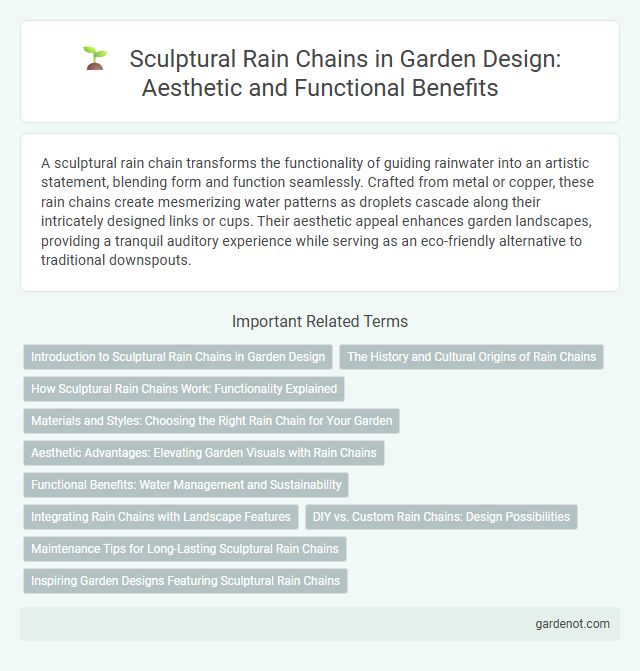A sculptural rain chain transforms the functionality of guiding rainwater into an artistic statement, blending form and function seamlessly. Crafted from metal or copper, these rain chains create mesmerizing water patterns as droplets cascade along their intricately designed links or cups. Their aesthetic appeal enhances garden landscapes, providing a tranquil auditory experience while serving as an eco-friendly alternative to traditional downspouts.
Introduction to Sculptural Rain Chains in Garden Design
Sculptural rain chains transform traditional water drainage systems into artistic focal points within garden design by guiding rainwater with aesthetic appeal. These rain chains, often crafted from materials like copper, brass, or steel, combine functionality with sculptural elegance, enhancing outdoor spaces. Integrating sculptural rain chains into gardens promotes sustainable water management while adding dynamic visual and auditory elements to the landscape.
The History and Cultural Origins of Rain Chains
Sculptural rain chains trace their origins to ancient Japan, where they were originally used as functional and decorative alternatives to traditional downspouts in temple architecture. Historically known as "kusari-doi," these chains guided rainwater gracefully from roofs to the ground or gutters, embodying a fusion of utility and aesthetic design deeply rooted in Japanese culture. Their evolution into artistic, sculptural forms reflects an enduring appreciation for natural elements and craftsmanship, highlighting the significance of rain chains in both historical and contemporary garden and architectural aesthetics.
How Sculptural Rain Chains Work: Functionality Explained
Sculptural rain chains function by guiding rainwater from gutters down to the ground or a catchment system through a series of linked cups or shapes that slow the flow and create a decorative cascade. These rain chains control water drainage effectively, reducing soil erosion and water pooling around foundations. Their open design allows water to move smoothly while adding an artistic element to traditional downspouts.
Materials and Styles: Choosing the Right Rain Chain for Your Garden
Sculptural rain chains crafted from durable materials like copper, brass, or stainless steel offer both functionality and artistic appeal, enhancing garden aesthetics while efficiently guiding water flow. Popular styles include cup-shaped, chain-link, and spiral designs, each providing unique visual effects and varying water movement patterns. Selecting the right rain chain involves balancing material longevity, weather resistance, and the desired sculptural impact to complement your garden's overall theme.
Aesthetic Advantages: Elevating Garden Visuals with Rain Chains
Sculptural rain chains transform functional water drainage into captivating garden art, enhancing outdoor aesthetics with their elegant, flowing designs. Crafted from materials like copper or brass, these rain chains develop a natural patina over time, adding a timeless, artistic charm to landscapes. Their rhythmic water movement creates soothing sounds that enrich the sensory garden experience while visually elevating garden visuals.
Functional Benefits: Water Management and Sustainability
Sculptural rain chains enhance water management by directing runoff efficiently from roofs to ground or storage systems, reducing soil erosion and preventing water damage. Their design promotes sustainable water use by channeling rainwater for irrigation or reuse, minimizing reliance on municipal supply. Crafted from durable, weather-resistant materials, these rain chains offer long-lasting performance with minimal maintenance.
Integrating Rain Chains with Landscape Features
Sculptural rain chains seamlessly integrate with landscape features by channeling rainwater from gutters to the ground through artistic, cascading designs that enhance garden aesthetics. Their unique forms, often inspired by natural elements like leaves or geometric shapes, complement plant arrangements and hardscaping, creating a cohesive outdoor environment. Proper placement near focal points such as water basins or stone pathways maximizes both functionality and visual appeal, making rain chains a sustainable and decorative water management solution.
DIY vs. Custom Rain Chains: Design Possibilities
Sculptural rain chains offer diverse design possibilities by blending functionality with artistic expression, allowing DIY enthusiasts to craft personalized patterns using materials like copper or brass for unique visual appeal. Custom rain chains elevate this creativity by enabling precise tailoring of shapes, sizes, and finishes to harmonize with architectural styles and garden themes. Both approaches enhance rainwater management while serving as striking sculptural elements that reflect individual taste and environmental integration.
Maintenance Tips for Long-Lasting Sculptural Rain Chains
Regular cleaning with mild soap and water prevents mineral buildup on sculptural rain chains, preserving their aesthetic appeal and function. Inspecting for corrosion or damage ensures timely repairs, extending the lifespan of metal or copper materials. Applying a protective sealant every few years guards against weathering, maintaining both structural integrity and vibrant finish.
Inspiring Garden Designs Featuring Sculptural Rain Chains
Sculptural rain chains transform garden spaces by combining functionality with artistic expression, guiding rainwater through elegant, cascading cups or links that double as captivating visual elements. These rain chains enhance garden aesthetics while promoting sustainable water drainage, creating soothing sounds that enrich outdoor ambiance. Integrating sculptural rain chains in inspiring garden designs elevates both the visual impact and environmental harmony of landscaping.
Sculptural rain chain Infographic

 gardenot.com
gardenot.com